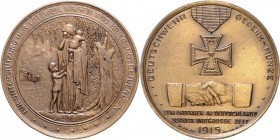Posted for: Darren Poley, Outreach and Theology Librarian, Villanova University
Prior to the entrance of the United States into the First World War, Deutschwehr, a German volunteer aid society often involving prominent socialites, was particularly active in and near Philadelphia, Pennsylvania. Deutschwehr may very well have been one of the “auxiliary organizations” to which Gen. Kurt von Pfuel, chairman of the central committee of the German Red Cross, mentions in his letter of appreciation written Feb. 25, 1915 which was later translated and published in The New York Times (April 9, 1915, p. 4, c. 3). The Deutschwehr motto: “He who helps his brothers does a noble deed.”
Reporting on the Deutschwehr-Fest, Riverside, N.J. which included a ball and a well-organized bazaar, a Philadelphia Inquirer news article indicates Deutschwehr activities were “to relieve the war suffers of the Central Powers of Europe” and headed by “the general committee with headquarters in Philadelphia” (May 7, 1916, p. 8, c. 3). Soon thereafter in the same newspaper a two column-wide advertisement with intended shock-value announced “Deutschwehr War Films” shown “for the benefit of war widows and babies” (May 14, 1916, p. 14, c. 7-8). The August 1916 records of The Relief Fund of Philadelphia (Hilfsfond), a German-American charity founded shortly after the beginning of World War One indicates it gave funds raised for civilian war relief in Germany and Austria-Hungary to both the Philadelphia office of the Berlin Deutschwehr and the German Red Cross (Rotes Kreuz). Nevertheless, a Philadelphia Inquirer feature later in the same year identifies Deutschwehr with the “German Red Cross” and said it was “one of the most potential aids to the cause of charity in the United States” with the purpose of “providing for the needy widows and orphans who survive slain soldier husbands and fathers” (Dec. 24, 1916, p. 7, c. 4-5).
Given the large number of German-born residents, the Attorney General of the United States issued a “circular communication” the day the U.S. declared war on the Central Powers, April 6, 1917. It stated, “No German alien enemy in this country, who has not hitherto been implicated in plots against the interests of the United States, need have any fear of action by the Department of Justice so long as he observes the following warning: Obey the law; keep your mouth shut” (The Philadelphia Inquirer, April 7, 1917, p. 1, c. 4). The suspicion of an uprising of America’s estimated 30 million German-Americans in favor of Pan-Germanism was a chimera. However in the teeth of anti-German zeal and especially after the U.S. entered the conflict, “Patriotic Americans of German lineage” were reorganizing to “Americanize Deutschwehr” in its efforts to “aid wounded and widows” (The Philadelphia Inquirer, April 23, 1917, p. 9, c. 4). Thus proving Americans with a German heritage were ‘for the United States first, last, and all the time’ as was quoted in a report about the 1916 series of Deutschwehr charity events “being held for the widows and orphans of German, Austrian, Hungarian, and their allied soldiers at Madison Square Garden” labeled a “Teutonic Bazaar” by The New York Times (March 14, 1916, p. 9, c. 3).
Although the American Red Cross in keeping with the Geneva Convention of 1906 attempted nationality-neutral aid to the sick and wounded in 1914 it wasn’t until after the United States declared war and President Wilson was made honorary chairman that the American Red Cross became the preeminent U.S.-based aid society for providing impartial relief at home and abroad. Some Deutschwehr publications preserved by The German Society of Pennsylvania have been digitized by Digital Library@Villanova University.

